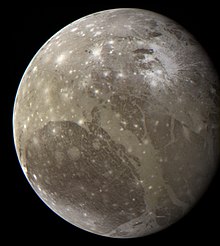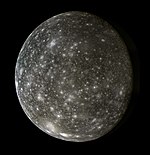Jupiter Icy Moons Explorer
This article documents a current or recent spaceflight. Details may change as the mission progresses. Initial news reports may be unreliable. The last updates to this article may not reflect the most current information. For more information please see WikiProject Spaceflight. |
| File:JUICE spacecraft.png Artist's impression of the JUICE spacecraft | |||||||||||||||||||||||
| Names | JUICE | ||||||||||||||||||||||
|---|---|---|---|---|---|---|---|---|---|---|---|---|---|---|---|---|---|---|---|---|---|---|---|
| Mission type | Planetary science | ||||||||||||||||||||||
| Operator | ESA | ||||||||||||||||||||||
| COSPAR ID | 2023-053A | ||||||||||||||||||||||
| SATCAT no. | 56176 | ||||||||||||||||||||||
| Mission duration | Cruise phase: 8 years Science phase: 3.5 years | ||||||||||||||||||||||
| Spacecraft properties | |||||||||||||||||||||||
| Manufacturer | Airbus Defence and Space | ||||||||||||||||||||||
| Launch mass | 5,963 kg (13,146 lb) | ||||||||||||||||||||||
| Dry mass | 2,405 kg (5,302 lb) | ||||||||||||||||||||||
| Power | 820 watts[1] from a solar panel ~100 m2 (1,100 sq ft)[2] | ||||||||||||||||||||||
| Start of mission | |||||||||||||||||||||||
| Launch date | 14 April 2023 12:14:29 UTC[3] | ||||||||||||||||||||||
| Rocket | Ariane 5 ECA | ||||||||||||||||||||||
| Launch site | Centre Spatial Guyanais, ELA-3 | ||||||||||||||||||||||
| Contractor | Arianespace | ||||||||||||||||||||||
| Flyby of Moon | |||||||||||||||||||||||
| Closest approach | August 2024 | ||||||||||||||||||||||
| Flyby of Earth | |||||||||||||||||||||||
| Closest approach | August 2024 | ||||||||||||||||||||||
| Flyby of Venus | |||||||||||||||||||||||
| Closest approach | 31 August 2025 | ||||||||||||||||||||||
| Flyby of Earth | |||||||||||||||||||||||
| Closest approach | 29 September 2026 | ||||||||||||||||||||||
| Flyby of Earth | |||||||||||||||||||||||
| Closest approach | 18 January 2029 | ||||||||||||||||||||||
| Flyby of 223 Rosa | |||||||||||||||||||||||
| Closest approach | 15 October 2029 (proposed) | ||||||||||||||||||||||
| Jupiter orbiter | |||||||||||||||||||||||
| Orbital insertion | July 2031 (planned) | ||||||||||||||||||||||
| Orbital departure | December 2034 | ||||||||||||||||||||||
| Ganymede orbiter | |||||||||||||||||||||||
| Orbital insertion | December 2034 (planned) | ||||||||||||||||||||||
| Orbital parameters | |||||||||||||||||||||||
| Periapsis altitude | 500 km (310 mi) | ||||||||||||||||||||||
| Apoapsis altitude | 500 km (310 mi) | ||||||||||||||||||||||
| |||||||||||||||||||||||
| JUICE mission logo JUICE mission insignia | |||||||||||||||||||||||
The Jupiter Icy Moons Explorer (JUICE) is an interplanetary spacecraft that was launched on 14 April 2023 by the European Space Agency (ESA) with Airbus Defence and Space as the main contractor. The mission will study three of Jupiter's Galilean moons: Ganymede, Callisto, and Europa, all of which are thought to have significant bodies of liquid water beneath their surfaces, making them potentially habitable environments.[4][5] The mission is not focused on volcanically active Io, a non-icy moon.
The spacecraft launched on 14 April 2023 at 12:14 UTC[3] and will reach Jupiter in July 2031 after four gravity assists and eight years of travel.[6][7] In December 2034, the spacecraft will enter orbit around Ganymede for its close up science mission,[6] becoming the first spacecraft to orbit a moon other than the Moon of Earth. The selection of this mission for the L1 launch slot of ESA's Cosmic Vision science programme was announced on 2 May 2012.[8][9] Its period of operations will overlap with NASA's Europa Clipper mission, launching in 2024.
History

The mission started as a reformulation of the Jupiter Ganymede Orbiter proposal, which was to be ESA's component of the cancelled Europa Jupiter System Mission – Laplace (EJSM-Laplace).[10] It became a candidate for the first L-class mission (L1) of the ESA Cosmic Vision Programme, and its selection was announced on 2 May 2012.[8]
In April 2012, JUICE was recommended over the proposed Advanced Telescope for High Energy Astrophysics (ATHENA) X-ray telescope and a gravitational wave observatory (New Gravitational wave Observatory (NGO)).[11][12]
In July 2015, Airbus Defence and Space was selected as the prime contractor to design and build the probe, to be assembled in Toulouse, France.[13]
This section needs expansion. You can help by adding to it. (April 2022) |
Timeline
Launch and trajectory
JUICE was to be launched on 13 April 2023 on an Ariane 5 launch vehicle from the Guiana Space Centre[14] but due to poor weather the launch was postponed until 14 April.[15] Following the launch, there will be multiple planned gravity assists to put JUICE on a trajectory to Jupiter: a flyby of the Earth–Moon system in August 2024, Venus in August 2025, second flyby of Earth in September 2026, and a final third flyby of Earth in January 2029.[6]
JUICE will pass through the asteroid belt twice. A flyby of the asteroid 223 Rosa has been proposed, and would occur in October 2029.[16][17]
Arrival at the Jovian system
When it arrives in Jupiter's system in July 2031, JUICE will first perform a flyby of Ganymede in preparation for Jupiter orbital insertion ≈ 7.5 hours later. The first orbit will be elongated, with subsequent orbits gradually lowered over time, resulting in a circular orbit around Jupiter.[6]
The first Europa flyby will take place in July 2032. JUICE will enter a high inclination orbit to allow exploration of Jupiter's polar regions and to study Jupiter's magnetosphere.[6]
Orbital insertion on Ganymede
In December 2034, JUICE will enter an elliptical orbit around Ganymede, becoming the first spacecraft to orbit a moon other than Earth's Moon. The first orbit will be at a distance of 5,000 km (3,100 mi). In 2035, JUICE will enter a circular orbit 500 km (310 mi) above the surface of Ganymede.[6] JUICE will study Ganymede's composition and magnetosphere among other things.
Planned deorbit on Ganymede
When the spacecraft consumes its remaining propellant, JUICE is planned to be deorbited and impact Ganymede at the end of 2035.[6]
Science objectives


The JUICE orbiter will perform detailed investigations on Ganymede and evaluate its potential to support life. Investigations of Europa and Callisto will complete a comparative picture of these Galilean moons.[18] The three moons are thought to harbour internal liquid water oceans, and so are central to understanding the habitability of icy worlds.
The main science objectives for Ganymede, and to a lesser extent for Callisto, are:[18]
- Characterisation of the ocean layers and detection of putative subsurface water reservoirs
- Topographical, geological and compositional mapping of the surface
- Study of the physical properties of the icy crusts
- Characterisation of the internal mass distribution, dynamics and evolution of the interiors
- Investigation of Ganymede's tenuous atmosphere
- Study of Ganymede's intrinsic magnetic field and its interactions with the Jovian magnetosphere.
For Europa, the focus is on the chemistry essential to life, including organic molecules, and on understanding the formation of surface features and the composition of the non-water-ice material. Furthermore, JUICE will provide the first subsurface sounding of the moon, including the first determination of the minimal thickness of the icy crust over the most recently active regions.
More distant spatially resolved observations will also be carried out for several minor irregular satellites and the volcanically active moon Io.
Spacecraft
Design drivers
The main spacecraft design drivers are related to the large distance to the Sun, the use of solar power, and Jupiter's harsh radiation environment. The orbit insertions at Jupiter and Ganymede and the large number of flyby manoeuvres (more than 25 gravity assists, and two Europa flybys) requires the spacecraft to carry about 3,000 kg (6,600 lb) of chemical propellant.[19]
Gravity assists include:[20]
- Interplanetary transfer (Earth, Venus, Earth, Mars, Earth)
- Jupiter orbit insertion and apocentre reduction with multiple Ganymede gravity assists
- Reduction of velocity with Ganymede–Callisto assists
- Increase inclination with 10–12 Callisto gravity assists
Science instruments

On 21 February 2013, after a competition, 11 science instruments were selected by ESA, which are being developed by science and engineering teams from all over Europe, with participation from the US.[21][22][23][24]
Japan will also contribute several components for SWI, RPWI, GALA, PEP, JANUS and J-MAG instruments, and will facilitate testing.[25][26][27]
Jovis, Amorum ac Natorum Undique Scrutator (JANUS)
The name is Latin for "comprehensive observation of Jupiter, his love affairs and descendants."[28] A camera system to image Ganymede and interesting parts of the surface of Callisto at better than 400 m/pixel (resolution limited by mission data volume). Selected targets will be investigated in high-resolution with a spatial resolution from 25 m/pixel down to 2.4 m/pixel with a 1.3° field of view. The camera system has 13 panchromatic, broad and narrow-band filters in the 0.36 µm to 1.1 µm range, and provides stereo imaging capabilities. JANUS will also allow relating spectral, laser and radar measurements to geomorphology and thus will provide the overall geological context.
- Principal investigator: P. Palumbo, Parthenope University of Naples, Italy.
- Co-investigator: J. Haruyama, JAXA, Japan.
- Lead funding agency: ASI, Italy.
Moons and Jupiter Imaging Spectrometer (MAJIS)
A visible and infrared imaging spectrograph operating from 400 nm to 5.70 µm, with spectral resolution of 3–7 nm, that will observe tropospheric cloud features and minor gas species on Jupiter and will investigate the composition of ices and minerals on the surfaces of the icy moons. The spatial resolution will be down to 75 m (246 ft) on Ganymede and about 100 km (62 mi) on Jupiter.
- Principal investigator: F. Poulet, Institut d'Astrophysique Spatiale, France.
- Lead funding agency: CNES, France.
UV Imaging Spectrograph (UVS)
An imaging spectrograph operating in the wavelength range 55–210 nm with spectral resolution of <0.6 nm that will characterise exospheres and aurorae of the icy moons, including plume searches on Europa, and study the Jovian upper atmosphere and aurorae. Resolution up to 500 m (1,600 ft) observing Ganymede and up to 250 km (160 mi) observing Jupiter.
- Principal investigator: R. Gladstone, Southwest Research Institute, United States.
- Lead funding agency: NASA, United States.
Sub-millimeter Wave Instrument (SWI)
A spectrometer using a 30 cm (12 in) antenna and working in 1080–1275 GHz and 530–601 GHz with spectral resolving power of ~107 that will study Jupiter's stratosphere and troposphere, and the exospheres and surfaces of the icy moons.
- Principal investigator: P. Hartogh, Max Planck Institute for Solar System Research, Germany.
- Co-investigator: Y. Kasai NICT, Japan.
- Lead funding agency: DLR, Germany.
Ganymede Laser Altimeter (GALA)
A laser altimeter with a 20 m (66 ft) spot size and 10 cm (3.9 in) vertical resolution at 200 km (120 mi) intended for studying topography of icy moons and tidal deformations of Ganymede.
- Principal investigator: H. Hussmann, DLR, Institute for Planetary Research, Germany.
- Co-investigator: K. Enya, JAXA, Japan.
- Lead funding agency: DLR, Germany.
- Developer & Manufacturer: Hensoldt Optronics GmbH, Oberkochen, Germany.
Radar for Icy Moons Exploration (RIME)
An ice-penetrating radar working at frequency of 9 MHz (1 and 3 MHz bandwidth) emitted by a 16 m (52 ft) antenna; will be used to study the subsurface structure of Jovian moons down to 9 km (5.6 mi) depth with vertical resolution up to 30 m (98 ft) in ice.
- Principal investigator: L. Bruzzone, University of Trento, Italy.
- Lead funding agency: ASI, Italy.
JUICE-Magnetometer (J-MAG)

Will study the subsurface oceans of the icy moons and the interaction of Jovian magnetic field with the magnetic field of Ganymede using a sensitive magnetometer.
- Principal investigator: Michele Dougherty, Imperial College London, United Kingdom.
- Co-investigators A. Matsuoka, Kyoto University, Japan. Space Research Institute (IWF-OEAW) Graz, Austria. Technical University Braunschweig, Germany.
- Lead funding agency: UKSA, United Kingdom.
Particle Environment Package (PEP)
A suite of six sensors to study the magnetosphere of Jupiter and its interactions with the Jovian moons. PEP will measure positive and negative ions, electrons, exospheric neutral gas, thermal plasma and energetic neutral atoms present in all domains of the Jupiter system from 1 meV to 1 MeV energy.
- Principal investigator: S. Barabash, Swedish Institute of Space Physics, Sweden.
- Co-principal investigators: P. Wurz, University of Bern, Switzerland; P. Brandt, JHU/APL, United States.
- Lead funding agency: SNSA, Sweden.
Radio and Plasma Wave Investigation (RPWI)
Will characterise the plasma environment and radio emissions around the spacecraft, it is composed of four experiments: GANDALF, MIME, FRODO and JENRAGE. RPWI will use four Langmuir probes, each one mounted at the end of its own dedicated boom, and sensitive up to 1.6 MHz to characterize plasma and receivers in the frequency range 80 kHz to 45 MHz to measure radio emissions. This scientific instrument is somewhat notable for using Sonic as part of its logo.[29][30]
- Principal investigator: J.-E. Wahlund, Swedish Institute of Space Physics, Sweden.
- Co-principal investigators: B. Cecconi, Obs. Paris, France; Y. Kasaba, Tohoku University, Japan; I. Müeller-Wodarg, ICL, UK; H. Rothkaehl, CBK, Poland; O. Santolik, IAP, Czech Republic.
- Lead funding agency: SNSA, Sweden.
Gravity and Geophysics of Jupiter and Galilean Moons (3GM)
3GM is a radio science package comprising a Ka transponder and an ultrastable oscillator.[31] 3GM will be used to study the gravity field – up to degree 10 – at Ganymede and the extent of internal oceans on the icy moons, and to investigate the structure of the neutral atmospheres and ionospheres of Jupiter (0.1 – 800 mbar) and its moons.
- Principal investigator: L. Iess, Sapienza University of Rome, Italy.
- Lead funding agency: ASI, Italy.
Planetary Radio Interferometer and Doppler Experiment (PRIDE)
The experiment will generate specific signals transmitted by JUICE's antenna and received by very-long-baseline interferometry to perform precision measurements of the gravity fields of Jupiter and its icy moons.
- Principal investigator: L. Gurvits, Joint Institute for VLBI in Europe, Netherlands.
- Lead funding agency: NWO and NSO, Netherlands.
See also
- 17776, a speculative fiction work featuring a sentient JUICE
- Exploration of Jupiter
- Europa Clipper – Planned NASA space mission to Jupiter
- Galileo – former Jupiter orbiter
- Juno – current Jupiter orbiter
- Jupiter flybys: Pioneer 10 / 11; Voyager 1 / 2; Ulysses; Cassini–Huygens; New Horizons
References
- ^ Pultarova, Tereza (24 March 2017). "Europe's Jupiter explorer mission moves to prototype production". SpaceNews. Retrieved 25 March 2017.
- ^ Amos, Jonathan (9 December 2015). "Juice mission: Deal signed to build Jupiter probe". BBC News.
- ^ a b European Space Agency: Blast off for Jupiter icy moons mission BBC News, 2023-04-14.
- ^ Clark, Stuart (5 March 2023). "'It's like finding needles in a haystack': the mission to discover if Jupiter's moons support life". The Guardian. Retrieved 7 March 2023.
- ^ "ESA—Selection of the L1 mission" (PDF). 17 April 2012.
- ^ a b c d e f g "Juice's journey and Jupiter system tour". ESA. 29 March 2022. Retrieved 3 April 2022.
- ^ "JUpiter ICy moons Explorer (JUICE)". NSSDC. NASA. 28 October 2021. Retrieved 10 November 2021.
- ^ a b "ESA selects 1bn-euro Juice probe to Jupiter". Jonathan Amos. BBC News. 2 May 2012.
- ^ Howell, Elizabeth (13 February 2017). "JUICE: Exploring Jupiter's Moons". Space.com. Retrieved 18 May 2020.
- ^ "JUICE (JUpiter ICy moons Explorer): a European-led mission to the Jupiter system" (PDF).
- ^ Lakdawalla, Emily (18 April 2012). "JUICE: Europe's next mission to Jupiter?". The Planetary Society.
- ^ Amos, Jonathan (19 April 2012). "Disappointed astronomers battle on". BBC News.
- ^ "Preparing to build ESA's Jupiter mission". European Space Agency. 17 July 2015.
- ^ "Juice on final stretch for launch to Jupiter". ESA. 10 February 2023. Retrieved 14 February 2023.
- ^ https://twitter.com/Arianespace/status/1646485391506042883
- ^ Avdellidou, C.; Pajola, M.; Lucchetti, A.; Agostini, L.; Delbo, M.; Mazzotta Epifani, E.; Bourdelle De Micas, J.; Devogèle, M.; Fornasier, S.; Van Belle, G.; Bruot, N.; Dotto, E.; Ieva, S.; Cremonese, G.; Palumbo, P. (2021). "Characterisation of the main belt asteroid (223) Rosa". Astronomy & Astrophysics. 656: L18. Bibcode:2021A&A...656L..18A. doi:10.1051/0004-6361/202142600. S2CID 244753425.
- ^ Warren, Haygen (20 March 2023). "As launch approaches, JUICE project manager discusses trajectories and science".
- ^ a b "JUICE—Science objectives". European Space Agency. 16 March 2012. Retrieved 20 April 2012.
- ^ "JUICE—Spacecraft". European Space Agency. 16 March 2012. Retrieved 20 April 2012.
- ^ "JUICE (JUpiter ICy moons Explorer)" (PDF). European Space Agency. March 2012. Retrieved 18 July 2013.
- ^ "ESA chooses instruments for its Jupiter Icy Moon Explorer". CSW. ESA. 21 February 2013. Retrieved 17 June 2013.
- ^ "JUICE science payload". European Space Agency. 7 March 2013. Retrieved 24 March 2014.
- ^ "The JUICE Instruments". CNES. 11 November 2013. Retrieved 24 March 2014.
- ^ "Jupiter Icy Moons Explorer (JUICE): Science objectives, mission and instruments" (PDF). 45th Lunar and Planetary Science Conference (2014). Retrieved 24 March 2014.
- ^ "JUICE-JAPAN". JUICE-JAPAN.
- ^ Current Status of Japanese Participation to Jupiter Icy Moons Explorer "JUICE" Saito, Y.; Sasaki, S.; Kimura, J.; Tohara, K.; Fujimoto, M.; Sekine, Y. AGU; Fall Meeting Abstracts. Published in December 2015. Bibcode: 2015AGUFM.P11B2074S
- ^ [1] and [2] – Japan's contributions to JUICE instruments (in Japanese)
- ^ Köhler, Ulrich (December 2021). "Of Distant Moons and Oceans" (PDF). DLRmagazine. pp. 34–37.
- ^ "木星氷衛星探査機に搭載の電波観測装置が「ソニック・ザ・ヘッジホッグ」と共に木星へ|お知らせ|東北大学大学院理学研究科・理学部". www.sci.tohoku.ac.jp. Retrieved 21 January 2023.
- ^ "Actual Space Mission Picks Sonic The Hedgehog As An Official Mascot". Kotaku. 3 October 2019. Retrieved 21 January 2023.
- ^ Shapira, Aviv; Stern, Avinoam; Prazot, Shemi; Mann, Rony; Barash, Yefim; Detoma, Edoardo; Levy, Benny (2016). "An Ultra Stable Oscillator for the 3GM experiment of the JUICE mission". 2016 European Frequency and Time Forum (EFTF). pp. 1–5. doi:10.1109/EFTF.2016.7477766. ISBN 978-1-5090-0720-2. S2CID 2489857.















